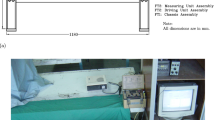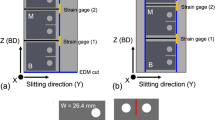Abstract
Damage identification due to fatigue has been studied on 304-Stainless Steel and Al-Cu-Mg alloys 2014-T651 and 7175-T7351, using two different experimental methods: a) cyclic indentation, and b) infrared thermography. Indentation response during load controlled cyclic loading is used to characterize fatigue response of materials. The load vs. depth of penetration data obtained continuously during fatigue testing is used to obtain information on cyclic stress-strain behavior and onset of failure.
Infrared thermography is used to study the heat generation during fatigue loading on specimens. The variables that affect the process are: frequency of loading, magnitude of strain (elastic-plastic), thermal properties. The temperature curve can be considered to be having three regions, initial region of rapid increase in temperature, followed by stable temperature rise and final rapid heat generation prior to failure. The slopes in the initial region and stable region are independent of prior damage history in materials in case of specimens subjected to pure elastic load reversals. In case of elastic-plastic loadings, the rate at which the temperature rises in initial region changes as a function of fatigue damage and can thus be used to estimate prior damage in materials.
Similar content being viewed by others
References
Manahan M P, Williams J and Mariakanit, R P, “Laser Weld Reconstitution of Conventional Charpy and Miniaturized Notch Tension Specimens”, ASTM STP 1204, ASTM, Pa, (1993) 62.
Nunomura S, Nishijima T, Higo Y and Hishinuma A, “Evaluation of Tensile Properties using a TEM disk-size specimen”, ASTM STP 1204, (1993) 256.
Sharpe W N Jr, Fowler R O, “A Novel Miniature Tension Test Machine”, ASTM STEP 1204, (1993) 386.
Jitsukawa S, Kizaki M, Umino A, Shiba K and Hishinuma A, “Methods and Devices for Small Specimen Testing at the Japan Atomic Energy Research Institute”, ASTM STP 1204, (1993) 289.
Garner F A, Hamilton M L, Helnisch H L and Kumar A S, “Application of Miniature Tension Specimens to Studies of Radiation Damage in Metals”, ASTM STP 1204, (1993) 336.
Kryukov A M and Sokolov M A, “Investigation of Material Bhevaior under reirradaiation after annealing using subsize specimens”, ASTM STP 1204, (1993) 417.
Rosinski S T and Kumar A S, Cannon S and Hamilton M L, “Application of subsize specimens in nuclear plant life extension”, ASTM STP 1204, (1993) 405.
Alexander D J, “ Fracture toughness measurements with sub-size disk compact specimens”, ASTM STP 1204, (1993) 130.
Tomimatsu M, Kuwaguchi S and Iida M, “Reconstitution of fracture toughness specimen for surveillance test”, ASTM STP 1329, (1998) 470.
Hirose T, Tanigawa H, Ando M, Suzuki T, Kohyama A, Katoh Y and Narui M, ASTM STP 1418, (2002) 181.
Murase Y, Nagakawa J and Yammamoto N, ASTM STP 1418, (2002) 211.
Li M and Stubbins J F, ASTM STP 1418, (2002) 321.
Haggag F M, Server W L, Lucas G E, Odette G R, Sheckherd J W, “The Use of Miniaturized Tests to Predict Flow Properties and Estimate Fracture Toughness in Deformed Steel Plates”, Journal of Testing and Evaluation, 1(1) (1990) 62.
Haggag F M, Wang J A, Sokolov M A and Murty K L, “ Use of Portable/In-Situ Stress-Strain Microprobe System to Measure Stress-Strain Behavior and Damage in Metallic Materials and Structures”, Non-Traditional Methods of Sensing Stress, Strain and Damage in Materials and Structures, ASTM STP 1318, Eds: G. Lucas and D. Stubbs, ASTM, Pa, (1997) 85.
Olurin O B, Fleck N A and Ashby M F, “Indentation Resistance of an Aluminum Foam”, Scripta Met., 43 (2000) 983.
ASTM standard E-606, ASTM Annual Book of Standards, 3.01 (2006) ASTM, Pa.
Nagy P M, Juhasz A, Voros Gy, Toth A and Ujvari T, “Internal Friction Measurement on Polymers by Low-Frequency Cyclic Vickers Micro-Indentation Test”, Materials Science and Engineering A, 387–389 (2004) 525.
Govindan Kutty T R, “Indentation Fatigue of Ceramic Nuclear Fuels”, Journal of Materials Science, 25 (1990) 455.
Abudaia F B, Evans J T and Shaw B A, “Spherical Indentation Fatigue Cracking”, Materials Science and Engineering A, 391 (2005) 181.
Pandey K N and Chand S, Deformation based temperature rise: a review. International Journal of Pressure Vessels and Piping, 80 (2003) 673.
Author information
Authors and Affiliations
Corresponding author
Rights and permissions
About this article
Cite this article
Prakash, R.V. Evaluation of fatigue damage in materials using indentation testing and infrared thermography. Trans Indian Inst Met 63, 173–179 (2010). https://doi.org/10.1007/s12666-010-0024-y
Received:
Revised:
Accepted:
Published:
Issue Date:
DOI: https://doi.org/10.1007/s12666-010-0024-y




